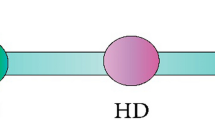Abstract
Objective
To describe the natural history of Sanfilippo syndrome type A.
Methods
We performed a retrospective review of 46 children (21 boys, 25 girls) with Sanfilippo syndrome type A evaluated between January 2000 and April 2013. Assessments included neurodevelopmental evaluations, audiologic testing, and assessment of growth, adaptive behavior, cognitive behavior, motor function, and speech/language skills. Only the baseline evaluation was included for patients who received hematopoietic stem cell transplantation.
Results
Median age at diagnosis was 35 months, with a median delay between initial symptoms to diagnosis of 24 months. The most common initial symptoms were speech/language delay (48 %), dysmorphology (22 %), and hearing loss (20 %). Early behavioral problems included perseverative chewing and difficulty with toilet training. All children developed sleep difficulties and behavioral changes (e.g., hyperactivity, aggression). More than 93 % of the children experienced somatic symptoms such as hepatomegaly (67 %), abnormal dentition (39 %), enlarged tongue (37 %), coarse facial features (76 %), and protuberant abdomen (43 %). Kaplan-Meier analysis showed a 60 % probability of surviving past 17 years of age.
Conclusions
Sanfilippo type A is characterized by severe hearing loss and speech delay, followed by a rapid decline in cognitive skills by 3 years of age. Significant somatic disease occurs in more than half of patients. Behavioral difficulties presented between 2 and 4 years of age during a rapid period of cognitive decline. Gross motor abilities are maintained during this period, which results in an active child with impaired cognition. Sleep difficulties are concurrent with the period of cognitive degeneration. There is currently an unacceptable delay in diagnosis, highlighting the need to increase awareness of this disease among clinicians.




Similar content being viewed by others
References
Baehner F, Schmiedeskamp C, Krummenauer F et al (2005) Cumulative incidence rates of the mucopolysaccharidoses in Germany. J Inherit Metab Dis 28:1011–1017
Bruininks R, Woodcock R, Weatherman R, Hill B (1996) Scales of independent behaviour-revised. Riverside, Chicago
Cleary MA, Wraith JE (1993) Management of mucopolysaccharidosis type III. Arch Dis Child 69:403–406
Crawley AC, Marshall N, Beard H et al (2011) Enzyme replacement reduces neuropathology in MPS IIIA dogs. Neurobiol Dis 43:422–434
Elliott CD (1990) The Differential Ability Scales (DAS). The Psychological Corp, San Antonio
Folio M, Fewell R (2000) Peabody developmental motor scales, 2nd edn. Pro-Ed, Austin
Haurigot V, Marco S, Ribera A et al (2013) Whole body correction of mucopolysaccharidosis IIIA by intracerebrospinal fluid gene therapy. J Clin Invest. doi:10.1172/JCI66778
Héron B, Mikaeloff Y, Froissart R et al (2011) Incidence and natural history ofmucopolysaccharidosis type III in France and comparison with United Kingdom and Greece. Am J Med Genet A 155A:58–68
Kuczmarski RJ, Ogden CL, Guo SS et al (2002) 2000 CDC growth charts for the United States: methods and development. National Center for Health Statistics. Vital Health Stat 11:246
Langford-Smith A, Wilkinson FL, Langford-Smith KJ et al (2012) Hematopoietic stem cell and gene therapy corrects primary neuropathology and behavior in mucopolysaccharidosis IIIA mice. Mol Ther: J Am Soc Gene Ther 20:1610–1621
Malm G, Mansson JE (2010) Mucopolysaccharidosis type III (Sanfilippo disease) in Sweden: clinical presentation of 22 children diagnosed during a 30-year period. Acta Paediatr 99:1253–1257
Martin HR, Poe MD, Reinhartsen D et al (2008) Methods for assessing neurodevelopment in lysosomal storage diseases and related disorders: a multidisciplinary perspective. Acta Paediatr Suppl 97:69–75
Meyer A, Kossow K, Gal A et al (2007) Scoring evaluation of the natural course of mucopolysaccharidosis type IIIA (Sanfilippo syndrome type A). Pediatrics 120:e1255–e1261
Meyer A, Kossow K, Gal A et al (2008) The mutation p.Ser298Pro in the sulphamidase gene (SGSH) is associated with a slowly progressive clinical phenotype in mucopolysaccharidosis type IIIA (Sanfilippo A syndrome). Hum Mutat 29:770
Mullen E (1995) The mullen scales of early learning. American Guidance Service, Circle Pines
Piotrowska E, Jakobkiewicz-Banecka J, Maryniak A et al (2011) Two-year follow-up of Sanfilippo Disease patients treated with a genistein-rich isoflavone extract: assessment of effects on cognitive functions and general status of patients. Med Sci Monit 17:CR196–CR202
Prasad VK, Mendizabal A, Parikh SH, Szabolcs P et al (2008) Unrelated donor umbilical cord blood transplantation for inherited metabolic disorders in 159 pediatric patients from a single center: influence of cellular composition of the graft on transplantation outcomes. Blood 112:2979–2989
Semel E, Wiig E, Secord W (2003) Clinical evaluation of language fundamentals, 4th edn. The Psychological Corporation, San Antonio
Valstar MJ, Ruijter GJ, van Diggelen OP, Poorthuis BJ, Wijburg FA (2008) Sanfilippo syndrome: a mini-review. J Inherit Metab Dis 31:240–252
Valstar MJ, Neijs S, Bruggenwirth HT et al (2010) Mucopolysaccharidosis type IIIA: clinical spectrum and genotype-phenotype correlations. Ann Neurol 68:876–887
Van de Kamp JJ, Niermeijer MF, von Figura K, Giesberts MA (1981) Genetic heterogeneity and clinical variability in the Sanfilippo syndrome (types A, B, and C). Clin Genet 20:152–160
Yogalingam G, Hopwood JJ (2001) Molecular genetics of mucopolysaccharidosis type IIIA and IIIB: diagnostic, clinical, and biological implications. Hum Mutat 18:264–281
Zimmerman I, Steiner V, Pond R (2002) Preschool language scale, 4th edn. The Psychological Corp, San Antonio
Competing interest
Dr. Escolar is a consultant for Shire Human. The content of the article has not been influenced by the sponsors.
Author information
Authors and Affiliations
Corresponding author
Additional information
Communicated by: Frits Wijburg
Rights and permissions
About this article
Cite this article
Buhrman, D., Thakkar, K., Poe, M. et al. Natural history of Sanfilippo syndrome type A. J Inherit Metab Dis 37, 431–437 (2014). https://doi.org/10.1007/s10545-013-9661-8
Received:
Revised:
Accepted:
Published:
Issue Date:
DOI: https://doi.org/10.1007/s10545-013-9661-8




